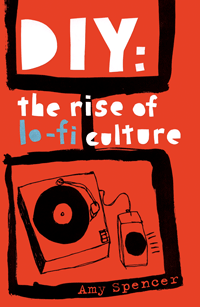Army of Amys
Thu. May 12, 2005Categories: Abstract Dynamics
‘Smell the lack of ambition….’ said I.T. as we subjected ourselves to shilly-shambling generic indie mumbling on Wednesday night. The occasion was the book launch for Amy Spencer’s ‘DIY: the Rise of Lo-Fi Culture,’ which we had been lured to by the intriguing ad posted by Simon SDS on Dissensus. The positing of a continuum embracing SF zines of the thirties, queercore, riot grrrl and blogs made for a fascinating prospect. Unfortunately, only a very narrow spectrum of that spectrum got much of an airing on Wednesday.

I suppose my suspicions were aroused by the subtitle of Spencer’s book. In a post-Akai age, why should DIY be lo-fi? With the rise of the cyberpunk technologies – samplers, PCs, DTP etc – the only explanation for smallness of sound is surely smallness of ambition.
At one point in Rip It Up Simon distinguishes between amateurism and amateurishness. In the period immediately before Morley and Penman turned to New Pop as a respite, messthetics had subsided into mere mess; the Scritti/ Slits/ Raincoats ambition to remake the world in sound had degenerated into comfortable ‘squattage industry’ the entryist Green would find it so easy to decry and disavow. A certain homespun, unassuming, untidy tininess had become a virtue in itself. The departure from rock spectacle had resulted in a proliferation of the avowedely diminutive, the homely. C86 was already on its way.
Wednesday night felt in many ways like it was C86 Forever. There were women dressed like the members of Talulah Gosh, in children’s-style anoraks and flower print dresses. A chap at the front was knitting. Literally.
Interspersed between the lo-fi music (about which, it is kinder to say nothing) were readings, from or inspired by live journals.
A distinction that hadn’t been that evident to us bloggaz beforehand was bandied about by the speakers as if it were a comonplace: the distinction between live journals and blogs. Weblogs, we were repeatedly told, make links; live journals, on the other hand, introspect. And the lo-fi continuum being celebrated here did in fact turn out to be a confederacy of introverts, if not to say solipsists. A certain bend-headed shyness seemed obligatory, so much so that it felt affected even if it wasn’t. (Perhaps it’s no accident that the blissblogmos which k-punk first found its unhome in was organized, however loosely, around the electronic communism of the rave discontinuum; the imaginary community for this lo-fi indie and live journal world, meanwhile, would be a network of bedrooms and bedsits, come, come share in my solitude.)
So, no mention of sf fanzines from the thirties, but oodles of footling about in an anti-rockist rock that, even as it has devolved into a pre-sexual infantilism, nevertheless retains reverence for a solid white male rock canon (Orange Juice, Byrds, Velvet fucking Underground). No change from 86, in other words, and on Wednesday my memories of that grim era came back in a visceral anti-rush. First year at university. Tyranny of indie. Expectations lowering. Subdivisions of passive-agressive Amys and Jemimas proffering sim-primary school doodlings.
What I remember about 86 was just how immensely liberating hip-hop and house felt then – sounds which were black not only ethnically, but also in a more abstract sense: darkly glistening, electrolibidinal, forming as stark a contrast as you like with the garishly dull kidz’ crayon pastels of indie’s baby teeth-white rock. I think of how hip hop has changed so much since then, but how this type of indie’s comfortable little cottage non-industry (artifice and effort being equally beyond indie’s very pale pale) has idled around playing pooh-sticks in the same shallow stream in the same suburban summer of the soul, unmoving and inviolate, ever since.
It strikes me that what is wrong with pop culture now is the poverty of its concepts of what success can be. Whereas this lo-fi culture has no concept of failure (middle-class kids who had piano lessons from the age of 4 pretending that they can only just about manage to blow into a kazoo just about covers it, I reckon), hip-hop’s Darwinian brutality is conditioned by a model of success that comes ready-made by Kapital. (It occurs me that what hip-hop needs is an immanent critique of those aspirations, which would function in the same way that punk operated in relation to glam. Mooching about in the existential desolation of their mansions on MTV cribs, who do today’s hip-hoppers resemble if not the Ferry of the 70s, trapped by the trappings of a success that, achieved too quickly, became a prison of conspicuous consumption?)
For all my problems with Grime, it is, of course, infinitely preferable to this lo-fi jingle-jangling about. The discrepancy between the Grimestaz sky’s-the-limit ambition and the ruff and readiness of what they produce makes for a drama, perhaps tragicomic but always noble, but such a possibility is a priori eliminated by indie’s tea-and-biscuits timorous mildness.
What’s powerful about DIY is its stiffening of punk will: the thought, especially thrilling to those not born into a cultural privilege, that what we can produce CAN matter. Or: we too can sublimate. That is a challenge, not a blank cheque. As opposed to: anything anyone does is good, especially if it sounds like no effort has been put into it whatsoever.
_________________________________________________________________
UPDATE: check out I.T.’s report of the same event. (It’s like blog Roshomon….)
_________________________________________________________________